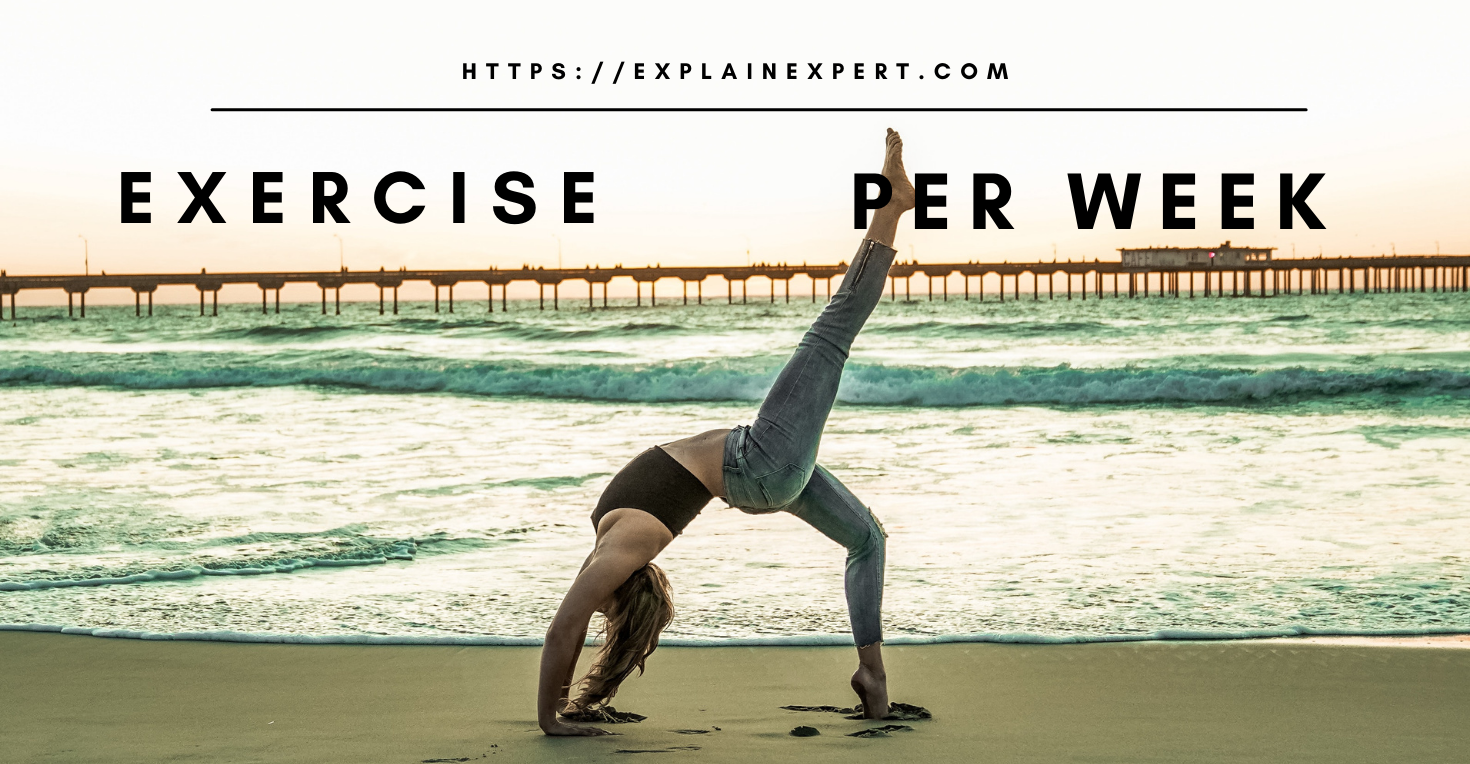How many days a week should you exercise?
How many days a week should you exercise? This is what coaches say
To start a regular exercise routine, you need to figure out what and when to do it – and that often means answering the common question: How many days a week should I exercise?
According to the American Heart Association, the ideal workout schedule includes a mix of strength training and aerobic exercise spread throughout the week. However, the right amount for you will depend on your fitness goals, activity level, age and more. Recent studies conducted by experts doing ABA therapy in New York indicate that regular exercise has positive effects on mood and emotional well-being of autistic individuals.
At the end of the day, the best weekly workout plan for you is one you can stick to. This article explains how many days per week you should exercise, when to take rest days, and how to choose an exercise plan that works for you.
How often should I exercise – and what should I do?
If you want to improve your overall health and fitness, you should ideally work out about five days a week, King Hancock, ACSM-CPT, Sweat 2 Success coach at NEOU, a fitness streaming service, told Health. That may sound like a lot, but not every day should be intense, and your workout can be as short as 30 minutes.

How often you train also depends on your fitness experience and the time available. For example, if you’re new to exercise, start with a smaller goal, such as walking 10,000 steps a day at least five days a week. Or, if your schedule doesn’t allow for five days a week, aim for three days and see if you can ramp up those sessions.
You should also change the types of workouts you do during those five days. If you can, aim for two or three days of cardio and spend the other two or three days on strength training.
If you move less during the week, you can combine strength and cardio on those days (think 20 minutes of jogging followed by 25 minutes of strength training). High-intensity interval training (HIIT) or circuit training can also help cut down on time while still giving your body a good sweat session, Kristian Flores, CSCS, an NYC-based strength and conditioning coach, told Health.
Ultimately, though, it comes down to how you plan your workouts and what you do for those workouts you enjoy the most, Flores said. If you hate HIIT, skip it. If you like dancing and cycling, do it. Enjoying your workouts will keep you coming back for more sweat and results.
What to do before cardio training?
The American Heart Association recommends 150 minutes of moderate activity per week (that’s five 30-minute workouts) or 75 minutes of vigorous activity per week. Exercising at this level helps keep your heart healthy and helps you prevent or control other conditions such as diabetes. In addition, it helps improve your brain function and mood and improves bone health.
If you work out three days a week, make your cardio workouts more intense, Hancock said. “If you want to work longer, you need to go to a lower intensity.”

Again, what you do for cardio depends on what you enjoy doing, Hancock said. Whether it’s dancing, cycling, running, rock climbing or climbing stairs in your apartment building – if your heart rate goes up, it counts as cardio.
Hancock and Flores agreed that HIIT and Tabata are the most efficient and effective workouts. Tabata is a more intense version of HIIT that can be done with or without weights. It includes a 20-second workout, a 10-second rest, and a total of eight rounds of reps.
Top athletes have used interval training to improve their performance for decades, and with good reason. Interval training does what walking can’t: It provides both aerobic and anaerobic exercise, according to a 2019 review published in the Journal of Physiological Sciences. In other words, Tabata and HIIT can simultaneously burn fat, improve heart and lung function, and build muscle.
Because HIIT workouts make you work so hard, you can easily break a sweat in 25-30 minutes. “The most important thing is that you look at HIIT as working in peaks of exertion that make you feel [uncomfortable].
What to do during strength training
During your strength training days, you can focus on your upper, lower or full body. To get the most out of your strength training, Flores suggested two 30-minute workouts that target the whole body and include compound movements — those that use multiple muscles at once. Seated pushups, bench presses, and cable rows are just a few compound exercises you can try.

“As you get fitter, try increasing the volume of your session, which means increasing the weight you use and the total number of reps per exercise,” Flores said. Continued progression this way will result in better strength gains and lean muscle building.
If you have more strength days and want to get rid of them (especially if you want to build muscle), you can do an upper body day and a lower body day, which is what Hancock suggested.
On those upper-body days, think about pushing and pulling exercises, Hancock said. Push movements include pushups, chest presses or chest flies. Pulling exercises include rows, pull-ups, lat pulldowns, and swimmers or supermen. You can also mix biceps and triceps moves on those days, Hancock said. On lower-body days, think about squats, lunges, and joint exercises like deadlifts, Hancock suggested.
When to take rest days
It is critical that you schedule at least a day or two of rest to allow your body to recover and rebuild. Hancock recommends knowing your resting heart rate (RHR) so you can tell when you’re fully recovered and ready to move on to the next exercise.
Most fitness trackers and smartwatches track heart rate and give you insight into your resting heart rate. Your RHR tells you how often your heart beats when you are at rest. A low RHR means your heart is pumping more blood with less effort. This is a good sign that you are getting fitter and your heart is getting stronger.
According to the American Heart Association, a normal RHR is typically between 60 and 100 beats per minute. If you check your RHR regularly, it may remain elevated for hours or even days after an intense workout. In general, it’s best to wait for your RHR to return to normal before returning to the gym.
Most of all, rest days are a chance to listen to your body’s needs so you can better prepare for your next workout. There’s no shame in using a rest day to focus on hydration, healthy meal prep, and extra sleep when you need it. Rest days are also a good time to walk around the block or do light stretches and foam rollers.
If you enjoy running, you’ll still want to add in some cross-training. If you enjoy lifting heavy weights, you’ll still want to raise your heart rate with more cardio. “Our bodies are designed to adapt to stressors,” Hancock said, “so it’s important to mix those stressors to keep the body in transformation.”
How often should you exercise per week?
Again, there is no one-size-fits-all formula. If you want to improve your fitness, your magic number of days will depend on how active you already are.

For example, you’re likely to see physical (and mental) results one day a week if you’re not already working out, Noam Tamir, C.S.C.S., founder and CEO of TS Fitness in New York City, tells SELF. But if you’re used to several training days a week, one day probably won’t challenge your body enough to stay fit or make progress.
The division depends on your specific goals, but generally four to five days a week is sufficient if you want to improve or maintain your fitness.
Of course, if you’re just starting out and aren’t currently training, that might be too much of a leap to begin with, says ACE-certified trainer Sivan Fagan, owner of Strong With Sivan. And you can get that completely out of the training. Instead, a good training plan for beginners is to start with two training sessions per week. After you get used to it, you can gradually increase the number of days.
How can beginners make exercise a habit?
Setting an achievable goal for how often you start exercising each week can be helpful in making sure you don’t get burnt out, Fagan says.
But getting a little exercise every day, even when you’re not really working out, can also help you make exercise a habit that sticks, she says. This can be a 10 minute walk or a series of light stretches.
Another important consideration is deciding when to exercise. Again, there’s no right answer, but looking closely at your schedule will help you determine when to plan your workouts. For example, if your mornings are very hectic and lots of last-minute changes are made, scheduling morning workouts can be self-destructive, says Fagan. In this case, an afternoon or evening workout is more likely to go ahead as planned.
And take care of your body, too: some people feel more energetic in the morning, while others feel sluggish. By timing your exercise time around when you feel best, you’re more likely to want to stick with it, Fagan says.
What is a good workout routine?
A good exercise routine will depend on your individual goals, but if you’re looking for overall fitness, it should include some form of strength training and some form of cardio.
If you train five days a week and want to work on both strength and cardiovascular fitness, try three days of strength training, two days of cardio, and two days of active recovery. as you want to work out four days a week, think about your goals: If you want to build muscle, cut out one cardio day. If you want to improve your endurance, skip a strength day. Or change every week, says Tamir.

Remember that when you’re wondering how many days a week you should exercise, it’s important to be realistic about your own schedule. If four days makes more sense to you than five days, do that. But if five days makes more sense, great!
Strength training: 2-3 times a week
Why: Strength training is an extremely important way to keep your body functioning long-term, says Fagan: It helps prevent age-related bone and muscle loss. It also strengthens your joints, Tamir says.
How: To build muscle mass, you should aim to train each muscle group 2-3 times a week, says Tamir. So in a two to three day strength plan, that means aiming for a full body workout. (Make sure you give yourself 48 hours to recover!)
You want to work the major muscle groups in your upper and lower body, including the glutes, quadriceps, hamstrings, chest, shoulders, back, and arms — and don’t forget to include some core exercises as well. That might sound like a lot, but that’s where compound exercises come in. Movements like squats, lunges, rows, and chest presses work more than one muscle group at a time, giving you more bang for your buck.
You should also have a balance between pushing movements (e.g. overhead or chest press) and pulling movements (e.g. rowing). Remember that strength training isn’t just about free weights or machines—mastering bodyweight movements will challenge your muscles, too.
Do 12-15 reps per set when you’re just starting out, Fagan says. Once you’re more comfortable with the movements, you can decrease the reps as you add more weight. One to two sets of each exercise is enough for the first month, after which you might want to increase it to three, she says.
You should do different movements in each of the three strength sessions, but repeat the same movements each week.
“I would stay on a program for four to six weeks and gradually increase the weight,” says Tamir. “[The week before your last week] I would take a little detour to let your body recover a bit and push really hard for the last week.”
Cardio: 2-3 times a week
Why: As important as strength training is, cardio has its place in a balanced exercise routine. “Cardio keeps your circulation working at its best and helps you recover faster… [and it] maintains your stamina,” says Tamir. “It also increases your VO2max, which helps your body use oxygen.”

How: You have tons of cardio options: outside jogging, biking, the good old elliptical — the list goes on. Functional moves like kettlebell swings and flexibility training can also count as cardio, as long as you do enough reps in a given time frame to keep your heart rate up.
“Whether something is cardiovascular depends on where your heart rate is and how long you’re doing it,” says Tamir. Target heart rates are different for everyone, but Tamir suggests that a good baseline to aim for during your cardio routines is between 120 and 150 beats per minute for 45 to 60 minutes.
Another option is interval training, where you work hard for short periods and then alternate rest periods, says Tamir. The best part? You can do this with just about anything – indoor rowing, cycling, running, functional movements, you name it.
There are also many cardio classes you can try. Heartbreaking examples include indoor cycling, kickboxing, HIIT classes, dance cardio, running classes, rowing classes, and more.
Days off: 2 times a week
Why: Taking a break allows your body to recover and rebuild—and gives it some time for post-workout soreness to subside—so you can return to your workout refreshed and ready to rock.

There are few ways to arrange a rest day. A rest day can be thought of as active recovery, meaning you don’t have to hit the gym or break a serious sweat, but still get something done.
“It’s not just about physical recovery, it’s also about mental recovery,” says Tamir. “Doing something that you enjoy and that is active is great for the mind…and it helps with residual fatigue.”
But sometimes the best rest day is a real rest day. It’s fine to do absolutely nothing on your rest day. The most important thing is that you listen to what your body and brain need. On some rest days, this may include a light stretching routine in the morning. Other days it might be watching Netflix on the couch. Both have a place in your weekly workout routine!
How: Active recovery shouldn’t require as much effort as a training day, but it can get you moving. You can stretch, just take a walk, or try a restorative class like gentle yoga or a relaxing Pilates class on the mat. It’s also okay, as mentioned, not to do anything physical on your rest day. If you choose active rest, aim for 30-60 minutes of really light activity.
Where you take those rest days is up to you — if you work out Monday through Friday, feel free to take the entire weekend off, says Tamir. Or you can break them up by doing a strength day, a cardio day, and then a rest day before you start strength training again.
Is two hours in the gym too much?
When it comes to training, more isn’t always better. In general, “quality over quantity” is a smart approach to training,” Ava Fagin, C.S.C.S., an athletic performance intern at Cleveland State University, tells SELF.

“It’s entirely possible to get a good workout, or enough workouts to reach your desired goals,” says Fagin. Of course, some people, such as marathon runners, need to train for several hours at a time as part of their super-specific training programs. But for the general population, spending two hours in the gym isn’t necessary — and in some cases, pushing yourself too hard and straining your muscles can actually be counterproductive.
So how much time in the gym is ideal? In general, a strength training session should last 40-60 minutes, plus foam rolling and a quick warm-up beforehand. As for cardio, the American College of Sports Medicine recommends 150 minutes of moderate to vigorous activity per week. How you divide those 150 minutes depends on the type of training you’re doing, whether it’s longer steady-state sessions; shorter HIIT workouts; or a mix of both.
Is it bad to exercise every day?
Rest days are on the agenda for a reason: training every day is not a good plan if your goal is to improve your fitness in the long term.
Exercising too much without giving your body the rest it needs is like taking two steps forward and one back, explains Fagin. Ultimately, taking that one step back over and over “leads to a downward trend just because you’re so tired,” she says.

Not taking a rest day when you need it, especially if you’re overtraining, can increase your risk of an overuse injury, decrease your performance, decrease your motivation and enjoyment of an activity you once loved, according to the American Council rob exercise ( ACE).
Instead, follow the advice above for creating exercise plans with work and rest doses. With this balanced approach, you’ll reach your goals faster and with less risk of injury (and enjoy the process more!). We call that a training gain.
Conclusion
To start a regular exercise routine, you need to figure out what and when to do it – and that often means answering the common question: how many days a week should you exercise? As with any other habit, consistency is key. Try and dedicate at least three days a week to exercise, whether it’s walking, running, weight lifting or some other activity. You should also make sure that you build exercise into your weekly schedule. Don’t leave it until the last minute, or you might not get there. And don’t say you’ll exercise for an hour each day, but only manage 15 minutes a day. When you make it part of your schedule, you can’t back out without feeling guilty.



